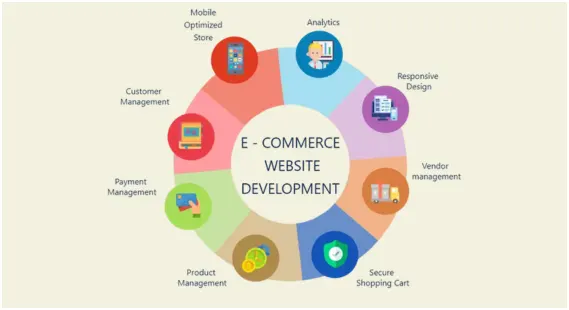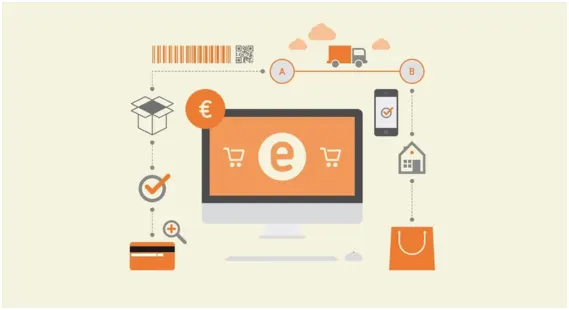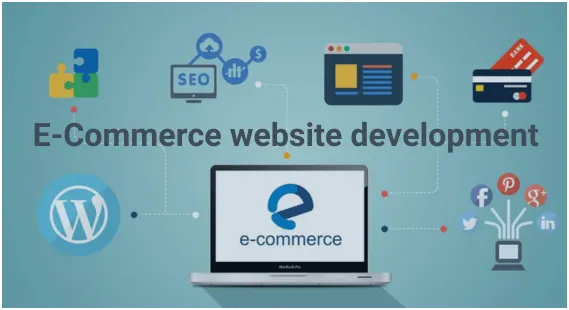E-commerce website development- how to improve your business with e-commerce website - in 2024
What Is the Development of E-Commerce Websites?
The process of developing an online marketplace where people may purchase and sell products and services is known as e-commerce website development. It is a complicated procedure. These websites often have a number of features and functionality, such as carts for shopping, gateways for payment, and product catalogues in general, that enable transactions on the internet.

Difference between Ecommerce Development and Other Types of Websites
There are some fundamental differences between e-commerce websites and other sorts of websites. E-commerce websites are primarily designed to handle consumer orders and facilitate payments, but other types of websites might include alternative or no primary goals.
Websites for e-commerce are also more sophisticated from other sorts of websites, owing to the wide range of available capabilities and features accessible. Furthermore, e-commerce websites frequently require enhanced authentication processes to secure client data as well as financial information.
Developing E-Commerce Websites: Crucial Subjects of Attention
Several important areas of attention should be taken into consideration while creating an e-commerce website. These are the following:
1. Responsive Design: An e-commerce website needs to be responsively constructed to succeed. To make the website readily viewable and navigable on any device, it should be able to adjust to various screen sizes and resolutions. To guarantee that customers may access the website on any device, responsive design is necessary for delivering a positive user experience.
2. SEO Proficiencies: When it comes to developing e-commerce websites, search engine optimisation is crucial. This is due to the fact that one of the most often used methods for customers to locate and buy things online is through search engines. Make sure your e-commerce website is appropriately optimised for search engines (SERPs) to guarantee that it shows up as high up as possible in the SERPs.
You must take a few steps to optimise your e-commerce website for search engine optimisation, such as:
- Locating and using pertinent keywords in the text of your website.
- Crafting product descriptions that are rich in keywords and quality.
- Developing interesting and educational blog material.
- Constructing backlinks from reputable domains to your website.
You will see improved search engine results, more traffic, and more sales if you invest the necessary effort in correctly optimising your e-commerce website for SEO.
3. Site Speed: The speed at which a page loads and becomes visible to users on your website is referred to as site speed.When developing an e-commerce website, this measure is crucial since a page that loads slowly might drive consumers away and to a rival, which could cost you revenue.
The size of your graphics, the amount of code on your page, and the response time of your server are some typical factors that might impact how quickly your website loads. Using caching plugins, selecting a quicker web server, and optimizing your graphics and code are some ways to increase the performance of your website. You can keep people satisfied and speed up your website by concentrating on these aspects.
4. Integrations: You will need to take into account a number of various connectors while developing your e-commerce website. These include making sure your website is mobile-friendly, linking your payment processor with your shopping cart, and setting up automated emails when purchases are placed. It is also necessary to configure the backend of your e-commerce website so that you can simply follow the movement of your items and manage and change them. A CRM can be useful at times for monitoring communications with both present and prospective clients.
Furthermore, you might need to think about using a cloud-based platform or integrating with a content management system (CMS) in accordance with the amount of content and length of your e-commerce site. A hosted solution will handle the creation and upkeep of your e-commerce website, while a content management system (CMS) will assist you with managing the material on your website.
How to Create A Custom E-Commerce Website in 7 Easy Steps

There are a few crucial actions that you must do if you want to create a unique e-commerce website. The degree of strategy and planning that goes into your development process will determine how successful your e-commerce website is.
The methods below will assist you in developing a website that is both user-friendly and safe, and that successfully satisfies the demands of both your company and your clients.
1. Choose the product you want to Sell
Choosing the goods or services you want to offer on your website is the first step. Before you can begin building your website, you must have a thorough grasp of your target market and the things they are searching for.
If you are a product seller, you must decide whether to sell digital items or tangible things that require shipping. It is advisable to contemplate your fulfilment tactics and the way you will manage the shipment and delivery procedure.
If you belong to the service business, consider what your clients are most interested in and how you may fulfil their needs via your website. Think about things like the payment methods you'll use, the customer service you'll offer, and the channels of contact you'll give them.
2. Determine The Business's Objectives.
Once you've decided what to market, it's critical to comprehend the overarching objectives of your business. This will guarantee that your website is made to fit your goals and assist direct the development process. Think of things like raising brand exposure, boosting revenue, or enhancing consumer satisfaction.
3. Identify the thing you want to experience when shopping.
The following stage is to ascertain the kind of online buying experience you would like your clients to enjoy. Consider what you want them to do and what information they should see.
Creating a user-friendly experience that motivates people to buy your goods or services is the aim. The purpose of the purchasing experience should be to further corporate objectives.
4. Discuss About Platform Selections.
A multitude of platforms are available for use in the development of e-commerce websites. It’s critical to go over the possibilities with your team and decide which best suits your requirements. Platforms like Smart e-commerce, Shopify, WooCommerce, and Magento are among the most well-liked choices.
The platform you choose will depend on factors including your business's general goals, the amount of customisation needed, and your budget. Selecting a platform that is readily scaleable as your business expands is a good idea.
5. Add products to your e-commerce site.
It's time to add things to your website after you've decided what you're going to offer and which platform to utilise. The degree of automation in this process will depend on the platform you use. While some platforms need you to manually enter the information, others let you import product data from external sources with ease.
You will enter product names, descriptions, prices, and photos while adding goods. Ensuring the accuracy and currentness of all product information is crucial. Additionally, you should make sure that add products to your e-commerce site.
6. Configure Shipping and Payment Options
Setting up your website's payment and delivery options is the next step. This will change based on the goods or services you are offering and the market you are trying to reach.
It is crucial to think through your money acceptance procedures as well as your shipping and delivery policies. The shipping and payment options you select will also have an impact on your website's security and customer service. Selecting a safe payment method that is well-known and easily available to your intended audience is crucial.
7. Launch an e-commerce website
Now that you have finished every step before, it is time to publish your website. Depending on the platform you select and the degree of customization you need, this procedure will change.
To get your website up and operating, you will probably need to deal with a developer or designer as most platforms provide a variety of customization choices. After your website is live, keep an eye on traffic and interaction data so you can adjust or improve it as needed.
Do you want to find a custom or ready e-commerce website development company in Bangladesh?
You might want to think about having Smart Software Limited custom code your e-commerce site if you're searching for a software development company that can provide you with a more specialized e-commerce solution or a comprehensive single and multi-vendor e-commerce solution. Find out more about Developing E-Commerce Websites Template.


 Best Jobs Site In Bangladesh - BDJobs Live. Best Online Recruitment Platform in Bangladesh
Best Jobs Site In Bangladesh - BDJobs Live. Best Online Recruitment Platform in Bangladesh
New Comment